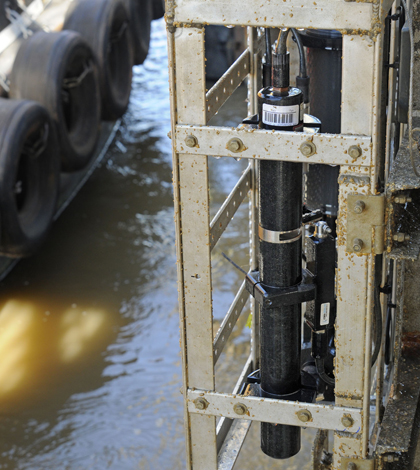Nutrient Sensor Challenge aims to coax market for next generation instruments

Recognizing nutrient pollution as a widespread but still poorly understood problem, U.S. federal environmental agencies are launching the Nutrient Sensor Challenge to jump-start the next generation of accessible tools for measuring nitrogen and phosphorous pollution.
While there are nutrient sensors on the market today, the cost and complexity of the instruments still prohibits the sort of widespread and continuous use needed to capture a detailed picture of the issue.
“You need a bunch of these sensors everywhere, so they need to be cheap and easy to use but still be accurate and precise,” said Mario Tamburri, director of the Alliance of Coastal Technologies. The alliance, something of a neutral force working improve sensor technology, is leading the challenge with along with the U.S. Environmental Protection Agency, U.S Geological Survey, National Oceanic and Atmospheric Administration, and other partners.
The Nutrient Sensor Challenge, which will be announced in greater detail at the fall meeting of the American Geophysical Union Dec. 15-19 in San Francisco, will give participants targets for cost, ease of use and data quality. Winners will be announced in 2016.
The challenge stems from a meeting convened around a year ago by the White House Office of Science and Technology Policy to scope out issues that cut across all the federal agencies dealing with the environment. From fertilizers on the land to phosphorus in surface water to dead zones in the Gulf of Mexico, nutrient pollution appeared to fit the mold. “One way or another, all these agencies had to deal with it,” Tamburri said.
And quantifying the problem was a universal challenge: Laboratory analysis of water samples is time-consuming, and the current generation of sensors that provide high-resolution, real-time data are expensive and require advanced training to use correctly. Rather than going the traditional route of funding research and development and hoping that a solution appears, the White House science office chose the challenge model that puts the reward at the end.
The various steps of the challenge will work to ease the risks of investing in R&D, Tamburri said. Though there may be modest cash rewards for the winners, the hope is that participating in the challenge itself will be a big part of the incentive. Participants will get access to beta testing environments, tips on bringing their tools to market, as well as information on potential demand.
“We’re not going to give them a check for million bucks, but we’re going to hand them a market that’s ready to go,” Tamburri said.

Nutrients flowing off the land, through the tributaries of the Mississippi River and out into the Gulf of Mexico demonstrate how nutrient pollution cuts across multiple federal agencies. (Credit: USGS)
The proceedings will kick off on Dec. 17 at the AGU meeting when NOAA Administrator Kathryn Sullivan officially announces the Nutrient Sensor Challenge and more details are released on the competition’s website. Tamburri said the initial applications, due around mid-March 2015, will be simple.
In summer 2015, the alliance will host events in the waters of the Great Lakes, Chesapeake Bay and an ocean setting for participants to test their prototypes. Alliance crews will collect water samples throughout the testing events and supply nutrient data to the teams to compare against their measurements. The tools won’t be judged at this point, and no one will see the data but the developers. The idea is to give participants some experience deploying their instruments while taking an early look at performance.
“The last thing we want to do is punish a good idea by testing it too soon,” Tamburri said. “We want them to shake it out a little bit — get some real world experience and work out those bugs,” he said.
The Alliance for Coastal Technologies will perform final lab and field testing on the instruments, generating neutral reports that don’t pick any winners or losers — the sort of report that ACT already specializes in for commercially available sensors. But those reports will go to a panel that will likely select first, second and third place winners for both nitrogen- and phosphorous-based sensors. There may also be “best in class” selections for entries that performed particularly well under one section of the criteria (cost or accuracy, for example) but didn’t make the top three.
“That’s the format that we’re trying to do,” Tamburri said. “And the ultimate goal is to fundamentally understand nutrient pollution so we can make some wise, strategic mitigation decisions to solve some of those problems.”
Top image: A Mississippi River nitrate sensor package at the Baton Rouge station. (Credit: USGS)





0 comments